(January/February 1932, 25m) Director: James Parrott Released: MGM, May 21, 1932 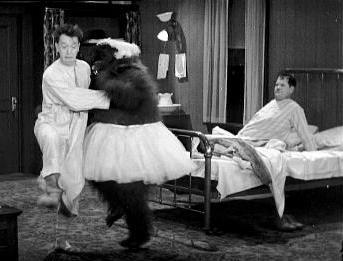 A punning title on the previous year's MGM boxing movie The Champ, this short reworks the theme seen in Angora Love and Laughing Gravy but removes it further from its original framework. Stan and Ollie accidentally destroy the circus where they work and so are forced to take a homeless chimp back to their apartment to live. Said chimp - actually a gorilla - can shrug, wink, fire guns and even dance a ballet wearing a tutu in a shameless sop to the younger generation. The gorilla itself was played by professional ape impersonator Charles Gemora, who would repeat the performance in Swiss Miss.   (February 1932, 19m) Director: James Parrott Released: MGM, June 25, 1932 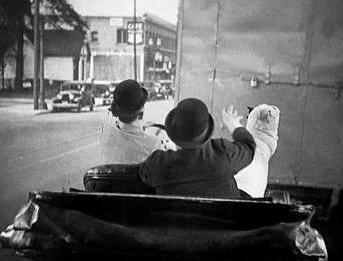 As with Hog Wild this short concludes with an out of control car sequence and said car being crushed out of shape between two trams. However what distinguishes County Hospital from that earlier entry is that County Hospital's final scene isn't remotely convincing. When Laurel and Hardy worked for Fox in the 1940s then poor back projection was almost a stock-in-trade, with one feature (The Dancing Masters) even using a toy bus to generate hollow thrills. However, the majority of the post-Roach features can be happily written off as a series of mistakes: Stan and Ollie forced to partake in films that were beneath them, made by people who didn't understand them. Yet here they are, within their prime, with classic movies still to be made, and they're reacting in front of stock footage that never looks even remotely realistic. Apologists have suggested that it's supposed to be the vision of speeding cars from a drugged Stan's point of view, or possibly a satire on cinema itself, though it can be perhaps little coincidence that in the Autumn of 1931 the Bank of America appointed a General Manager to oversee events at the Roach lot. With Hal Roach having loan troubles due to the depression, the unpopular Henry Ginsberg was appointed to make sure everything ran to schedule and to cost, in so doing creating a strained atmosphere in the creative environment. Although Ginsberg was finally replaced in 1936 with David Leow, a personal friend of Roach's, by then the growing rift between Hal and Stan was irreversible. It's unfortunate, because apart from its dreadful climax then County Hospital is consistently amusing, if unremarkable.    (April-June 1932, 68m) Director: George Marshall and Raymond McCarey Released: MGM, September 17, 1932 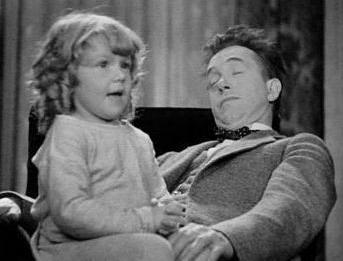 The first non-contemporaneous Laurel and Hardy film since Flying Elephants, and the first one to see them playing historical figures in their 'Stan and Ollie' personas, Pack Up Your Troubles has the duo drafted into World War I. While the use of war for comedy may seem an odd choice, when Pack Up Your Troubles was released the war had been over for nearly fourteen years... what could not be foreseen is that the war would begin again just seven years after the film's release. What's striking is that while the MGM and Fox movies cast them into patriotic roles, here their apoliticism shines through. A bombing raid only serves an irritation to Hardy while he's trying to drink his coffee, and the pair capture a battalion of Nazi troops not through proactive intent but through sheer incompetence. Although arguably more successful at sustaining a narrative than Pardon Us, Laurel and Hardy's second feature still seems uncertain as to how to fill out a feature-length runtime. As a result we meet their friend Eddie Smith, the first major character in a Laurel and Hardy film to be defined as 'real' and not part of their own super-annuated reality. Donald Dillaway's Eddie isn't a comic foil, but a serious character with unresolved parent issues who in turn finds the boys both an amusing diversion and a minor irritation. It's a strange divergence from the norm, whereby Dillaway treats the part as a proper acting role, not as an over-the-top comic 'turn', and Stan and Ollie take on a role of moral responsibility after Eddie is killed in the war, leaving his child with a brutal Uncle to look after her. As with previous entries like Beau Hunks and Any Old Port! there's a level of stark reality and sadistic violence on display, with Rychard Cramer only all-too-convincing as a wife beater and (implied) child beater, and Stan pouring boiling hot water over him to resolve their problems. The patchwork mix of such brutal characters, combined with extreme personas like Billy Gilbert and James Finlayson makes an uneven film at times. When three-year-old Jacquie Lyn becomes involved in the story as Eddie's sort-of orphaned daughter (Eddie's wife left them both in another unresolved plot strand) then it takes the film into territory where Laurel and Hardy had rarely been before. As with the previous year's Laughing Gravy, Stan and Ollie become self-consciously 'cute' and loveable personas, in scenes that will be sweet to some but far too saccharine to others. It's a line of progression that goes through the cartoonish The Chimp all the way to the made-for-children Babes In Toyland. Although Leo McCarey's son received an onscreen credit for the film it's rumoured that George Marshall directed the whole thing. Though Pack Up Your Troubles moves along at a fairly brisk pace it can be a little rigidly blocked, and Marshall has more of a presence in front of the camera as the psychotic chef.    (June 1932, 20m) Director: Raymond McCarey Released: MGM, September 10, 1932 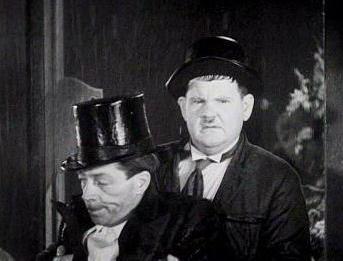 Stan and Ollie are vagrants told to leave town within twenty-four hours. However, an encounter with a wealthy drunken man sees them taken back to his home as guests. Unfortunately for the duo the drunk has got the wrong home, and he's taken them to the house of the judge. When Scram! was wrapped it marked the first significant break in production for the Laurel and Hardy series. Stan had planned to return home to visit his family, and, as Hardy had heard about the golf courses of Scotland, they decided to visit Britain as a joint holiday. They reached England on the 23rd July, by which time news of their arrival had leaked and massed crowds followed them wherever they went. Their time away from the studios continued all throughout August and into September, with them returning to filming on the 24th of that month. With such a hectic schedule it's perhaps not surprising that Scram! has little new for Stan and Ollie to do, and much of the schtick they perform is a retread of their own greatest hits from past movies. However, what puts this in stark contrast is that the drunk character is given so much that's fresh, and is played by Arthur Housman at the top of his game. The first of four Laurel and Hardy films to feature Housman (here credited as Houseman), he would later appear in The Live Ghost (1934), The Fixer Uppers (1935) and Our Relations (1936). Playing the role of a drunk in all four movies, behind the scenes Housman believed in meth(od) acting to its fullest. In a letter to a fan in January 1957 Stan recalled that 'Arthur was really a character, frankly I never saw him sober, he couldn't help being good in those parts he played, many times we would have to hold him up in a scene so he wouldn't fall down! Funny, but a bit pitiful at times. Strange as it may seem, years ago before this, he was quite handsome & used to play romantic leads.' Housman's pivotal role is a knockout turn, and with his physicality and devotion to the part he almost succeeds in stealing a fairly run of the mill short from its stars. The signs were clear that a break was due, and when Stan and Ollie returned to work their output once more reached great heights.    (September 1932, 21m) Director: George Marshall Released: MGM, November 5, 1932 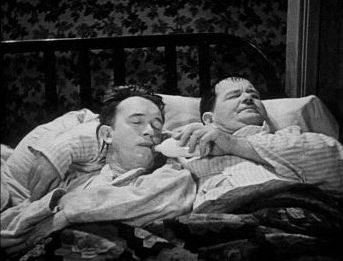 One of the famous quotes from Stan Laurel was given to the author John McCabe in an interview where he stated that 'we were just trying to make people laugh. Some people just don't believe that. They think deep down we all put some kind of bloody message in our films. Well, they're wrong. We were having fun and trying to give a little fun.' It's particularly prescient here with a short that's a myriad of Freudian imagery, to say nothing of their own real lives being reflected onscreen. Maybe Stan did create scenarios just for 'fun', but it's not difficult to assume that real-life problems had found their way onto film. Hardy had been sued for divorce by his second wife Myrtle in July 1929 and Stan had had his own marriage problems for some time. Though both marriages managed to last through this, Ollie receiving a divorce paper and Stan suggesting that he get a baby to repair his marriage were both poignant. With Stan's marriage to Lois falling apart, they stayed together for the sake of their own young daughter, and doubtless the pain of losing his son was still fresh in Stan's mind. That Hardy had a childless marriage and was forced to adopt in the short further complicated this mire of psychologically skewed double-meaning, whereby Ollie was cast in the role of estranged mother, Stan the father with the wife departed: 'You're just as much responsible for it as I am [...] you were the one that wanted me to have the baby. And now that you've got me into trouble you want to walk out and leave me flat. [...] What will my friends say? I'll be ostracised.' There's something eerily primal about seeing Stan's cries being echoed by that of a baby, or by Ollie believing Stan to be searching for his own breasts (Stan actually finds a milk bottle within his shirt) or, finally, Stan and Ollie in bed once more, this time Stan being bottle fed. The confusion of Hardy's affections over his wife only serve to make matters more complex: 'She says that I think more of you than I do of her.' 'Well, you do, don't you?' 'Well,' replies Hardy, 'we won't go into that.' Perhaps the only thing missing from Their First Mistake is a first-class ending. A scene where Hardy's wife returns with adopted babies of her own, having come to the same conclusion, was deleted, leaving a rather more unfocussed denouement.     (October/November 1932, 21m) Director: George Marshall Released: MGM, December 31, 1932 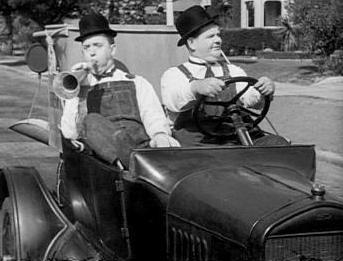 Other than an extremely brief guest appearance by Billy Gilbert as a boat seller, Towed In A Hole is a two-hander between Stan and Ollie alone. One of their most popular shorts (though personally I've always found it a little flat and overrated) and a return to the pure slapstick form - they buy a fishing boat and try to make it sea-worthy, with disastrous consequences - it nevertheless introduces something new into the Laurel and Hardy lexicon. Although Stan had tripped over his words before, Towed In The Hole marks the first instance of Ollie's 'tell me that again' - an instance where Stan would come up with an idea, be prompted to repeat it for clarity, then immediately forget what he's just said.    (November 1932, 20m) Director: James Parrott Released: MGM, February 25, 1933 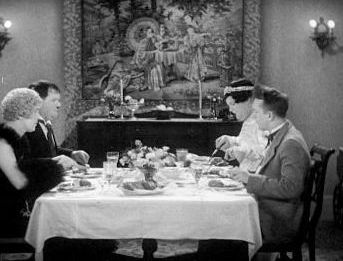 Twice Two sees Stan and Ollie celebrate their joint first wedding anniversary... to each other's sister. Despite the nature of Twice Two as one of the most frivolous, light-hearted Laurel and Hardy shorts, behind the scenes Stan's personal life was once more becoming fraught, as he and Lois separated, their relationship having collapsed. While it's possible to think that marriage issues played their way out in front of the camera and also reflect on the psychology behind Stan and Ollie wanting wives that physically resemble their best friend, the reality is probably just that having the two stars in drag was an old music hall/vaudeville tradition. (An amusing error to look out for is that when in his guise as Fanny, Hardy doesn't have make-up covering the tattoo on his right arm). The short is actually a perfect demonstration of the comedians tailoring their work to breakthroughs in cinema, not only using split screen longer than Brats, but also dubbing Stan and Ollie's voices while they're in their 'wives' personas (Fanny Laurel and an unnamed Mrs. Hardy). Sadly, this is perhaps where the film is most likely to divide viewers... while May Wallace (the nurse from County Hospital) does a fine female Ollie, Carol Tevis produces a shrill, shrieking harridan that will either delight audiences or set their teeth on edge. Despite reasonably innovative techniques, similarities with Twice Two and Brats are almost solely related to the initial gimmick alone. Whereas Brats took jokes and situations and elevated them, Twice Two relies on the conceit of the duo in drag, then goes nowhere with it beyond the initial reveal. The climax - female Hardy gets a cake in her face - shows that genuine inspiration may have been on hold for their third feature film, and that this one was just another in the series from the Hal Roach Lot. Having said all this, there are some nice touches of surrealism with telephones that squirt water and ink, and if you watch this after seeing any of the Fox films the difference in the chemistry and Stan's performance is marked. I'm contradicting myself badly here... this is what happens when you watch the entire run of Laurel and Hardy in order, then put Twice Two back on again to check some minor details... straight after you've watched the likes of A-Haunting We Will Go. It's this alone that means Twice Two scrapes an average mark by the very skin of its teeth.   
|
||||||||||||||||||||||||||||||||||||||||||||||||||||||||||||||||||||||||